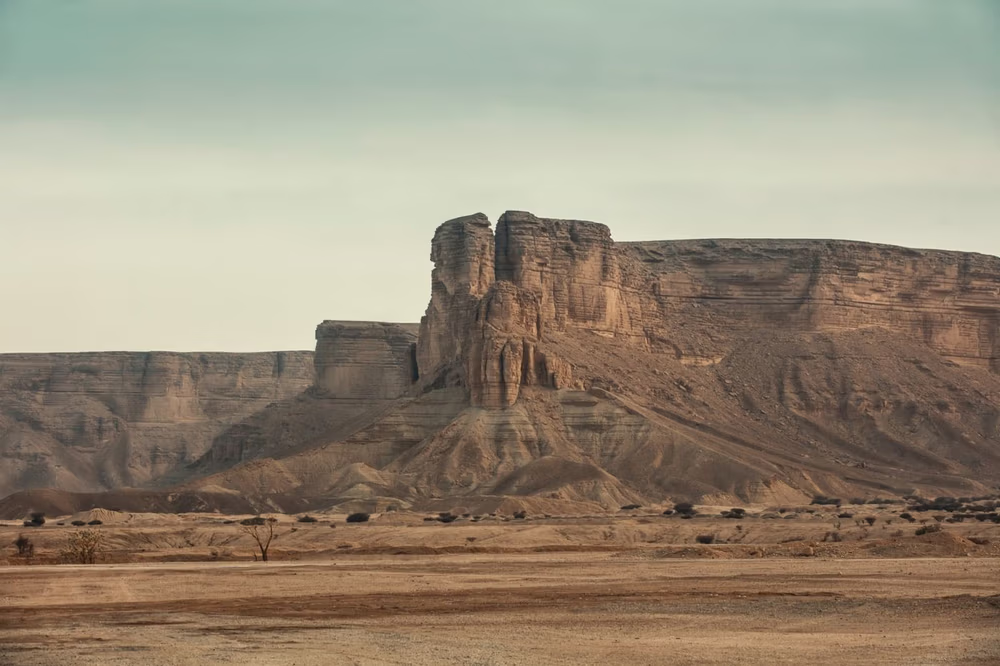Towering over the heart of the Arabian Peninsula, the Tuwaiq Mountain range stands as one of Saudi Arabia’s most enduring symbols of natural grandeur, historical legacy, and national identity. Spanning over 800 kilometers across central Najd, the range not only carves out a dramatic landscape but has also shaped the spirit and resilience of the Saudi people across generations.
Beginning in the sands of Al-Thuwayrat near Al-Zulfi and stretching southwards into the Empty Quarter, Tuwaiq’s rugged peaks and expansive valleys have been a source of strength and sustenance for centuries. Encompassed by the fertile lands of Al-Yamamah, the range is surrounded by thriving towns, villages, and valleys, most notably Wadi Hanifa, which cradles the modern capital, Riyadh.
Tuwaiq forms a prominent natural arc, visible even from space. Its distinctive geography—with gently sloping eastern flanks and steep western cliffs—has made it a vital ecological and historical corridor. Ancient historians such as Al-Hamdani, Al-Bakri, Al-Isfahani, and Al-Hamawi referenced its valleys and tributaries, underscoring the range’s deep-rooted cultural significance.
The Mountain That Shaped a Nation
Historically known as Jabal Al-Aridh or Aridh Al-Yamamah, the range lent its name to the Al-Aridh region, which encompasses Riyadh and nearby governorates, including Diriyah, Dhurma, and Al-Uyaynah. It has served as both a natural barrier and a cradle of civilization, where major cities and tribal settlements flourished even before the advent of Islam.
This towering range also inspired His Royal Highness Prince Mohammed bin Salman, Crown Prince and Prime Minister, in one of his most defining declarations:
“The strength of the Saudis is like that of the Tuwaiq Mountain.”
The phrase has since become a mighty rallying cry for Saudi youth and a cornerstone of the national spirit under Vision 2030.
Qiddiya: Vision 2030’s Jewel in the Mountains
Nestled within the Tuwaiq range is Qiddiya City, a visionary project set to redefine Saudi Arabia’s entertainment, sports, and cultural landscape. Located just 45 kilometers from Riyadh, Qiddiya was launched in 2018 when King Salman bin Abdulaziz laid its foundation stone. Today, it is the flagship venture of the Qiddiya Investment Company, designed to diversify the Kingdom’s economy and amplify its global presence.
With an expected contribution of SAR 135 billion annually to the GDP and 325,000 job opportunities across 200 sectors, Qiddiya is poised to become a global hub. Attractions include:
- Speed Park Track, featuring the world’s first cantilevered racetrack section.
- Falcons Flight is the world’s tallest, fastest, and longest roller coaster at Six Flags Qiddiya.
- Aquarabia is the largest water theme park in the region.
History Etched in Stone
According to historian Dr. Rashid Al-Asaker, Qiddiya’s name is derived from the word qid, meaning a natural cleft in the mountain. The Qiddiya Road, dating back over 3,000 years, cuts through Tuwaiq, connecting ancient trade routes that began in Hajar Al-Yamamah. The area features historical monuments and inscriptions, with restorations most recently carried out during the reign of King Abdulaziz in 1352 AH (1933 CE).
Tuwaiq in Saudi Identity
More than a geographic marvel, Tuwaiq is deeply ingrained in the national consciousness. It has inspired:
- The architectural Tuwaiq Palace is a hub for diplomacy and cultural dialogue in Riyadh.
- The naming of neighborhoods, sports clubs, magazines (e.g., Sada Tuwaiq), and major roadways across the Kingdom.
Tuwaiq is more than rock and ridge—it is a living testament to Saudi Arabia’s resilience, ambition, and unity. As the Kingdom charges forward with Vision 2030, the Tuwaiq Mountains remain a steadfast symbol of strength, reminding every Saudi citizen of their shared legacy and limitless future.
–Input WAM





